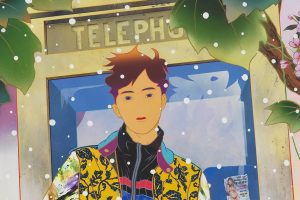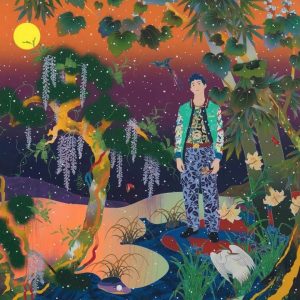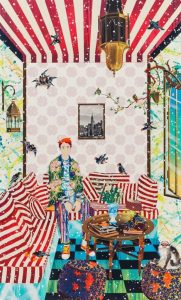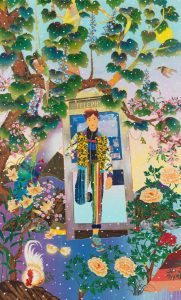Ayanna Dozier
Tomokazu Matsuyama’s incredibly detailed, invented worlds meld popular culture with historical painting traditions of the Western Renaissance and the Edo and Meiji periods in Japan. These largely figurative paintings feature people immersed in polychromatic landscapes and skies, often filled with foliage and other elements of nature.
Matsuyama’s work reflects his nomadic lived experience: He was born in Japan; spent his childhood split between there and Southern California; and moved to Brooklyn in the early 2000s, where he is currently based. Yet his paintings, murals, and sculptures transcend the binary East-meets-West framing that’s often used to describe his practice. More compelling is the way that Matsuyama interprets the collision of cultural symbols and styles. “My focal point is: What is it to be a global citizen? What is it to have a global identity? What does it mean to discuss identity in this day and age?” he explained in a recent interview with Artsy.
This May, Matsuyama’s painting Another Believer (2021) is the focus of a single-lot benefit auction running from May 12th through 26th. Proceeds from the Artsy-exclusive sale will go to the Asian American Arts Alliance (A4), an organization that promotes, supports, and shares resources for Asian artists working in the United States. The benefit auction came together through collaborating with Matsuyama’s Tokyo-based gallerist Kotaro Nukaga, who saw this collaboration as a way to amplify the artist’s efforts to build community with Asian cultural groups across the diaspora.

Tomokazu Matsuyama, detail of ‘Another Believer’ 2021. © Tomokazu Matsuyama. Courtesy of the artist.
Matsuyama is particularly committed to promoting fellow Asian diasporic artists working in the New York art world, which he considers still dominated by white male artists. “Now, it’s changing; African American artists are finally having a great voice in the art world, but Asian artists’ voices are still very much not heard,” he said. Matsuyama uses his studio and artistic practice to help bridge connections with other diasporic artists. In a way, this outreach combats the somewhat isolated experience he encountered as an emerging artist.
Matsuyama’s colorful and detailed compositions evidence his robust background in graphic design, having received his MFA in communications design from Pratt. He honed his painting skills, however, on his own, and developed them through working as a studio assistant for other painters in New York. “I am a self-taught painter,” Matsuyama said. “My first step into the contemporary art world was to be an assistant for a minimalist painter and I painted a bunch of circles.”

Tomokazu Matsuyama, ‘River To The Bank’ 2021; Side X Side Gallery; US$12,000
Matsuyama’s practice has grown over the past decade through gallery shows and, critically, major public artworks. He’s mounted LED digital installations, sculptures, and murals across Tokyo, Hong Kong, Beverly Hills, and New York. Such work has certainly impacted the critical and commercial response to his practice, seen through his recent market rise, including several new auction records set over the past year, as well as institutional recognition, such as his solo exhibitions in 2020 and 2021 at the Long Museum in Shanghai and Chongqing. In addition to being represented by Nukaga, Matsuyama signed on to Kavi Gupta’s roster in August 2021.
Another Believer (2021) is part of Matsuyama’s “Fictional Landscape” series (2021–present), his signature body of work that represents the in-betweenness he’s felt and been inspired by, given his own cultural background. The motley-colored fantastical landscapes fuse nature with the cosmos, sample compositions from classical Western paintings and popular fashion alike, and are often populated by flora and fauna characteristic of the Edo period. With each piece, Matsuyama blends together a variety of visual culture—advertisements, logos, magazine covers, modern art—and channels it all into the figures, textiles, and decor that are rendered through intricately layered brushstrokes.

Tomokazu Matsuyama, ‘Broken Train Pick Me’ 2021; The BlackWood Gallery

Tomokazu Matsuyama, ‘Another Believer’ 2021; Acrylic and mixed media on canvas; 100 × 60 in — 254 × 152.4 cm; Artsy Impact Auction; $180,000 (4 bids)
In Another Believer, we see a figure exiting a phone booth, which may recall to some the popular British TV series Doctor Who (1963–present). The booth is emerging from or sinking into a body of water, surrounded by an exuberant array of blooms, snowflakes, and trees. Matsuyama’s figure appears between worlds, galaxies, and time periods as he steps out into the world, wearing the freshest of outfits, which places him in the 21st century. This grounding in the present is amplified by the array of swimsuit magazines plastered inside the phone booth.
In the background, we find a psychedelic mixture of seasons, including the burst of spring dampened by the falling of snow. The conflicting dualities mirror Matsuyama’s experience of being in an environment, but not of it. Further, it conveys how individuals live with multiple cultures, truths, and time periods, all at the same time.
The roughly eight-foot-tall Another Believer was painstakingly crafted in the artist’s Greenpoint, Brooklyn, studio over the course of three months. Matsuyama’s studio functions like an atelier and features a team of 20 people that work with him across painting, sculpting, and administrative tasks. He likened his studio practice to the kitchen of a chef at a Michelin restaurant, mentoring a sous-chef who will eventually leave to go out on their own. If not for the aid of assistants, each large-scale work, like Another Believer, would easily take a year to complete alone, Matsusyama explained. He treats his studio assistants as apprentices, he explained, rather than mere hired labor.

Tomokazu Matsuyama, detail of ‘Another Believer’, 2021. © Tomokazu Matsuyama. Courtesy of the artist.
“Even with my own practice, I wanted to find a way to give [fellow artists] opportunities while they work for me,” he explained, adding that he looks for ways to support and mentor his team, including giving them studio space in the evenings and weekdays, curating their work into exhibitions, and even selling their work on occasion.
“I have many reasons as to why I have been working with Matsu,” Nukaga said, “but one of the reasons why I like him is because he supports Japanese artists in New York. He accepts many artists working in his studio and he gives them visas to work in New York. His studio is like a big school, and his studio produces many [great] artists.”
Matsuyama’s studio and art gives space for those who exist in between worlds. The artist himself still doesn’t feel quite at home in New York or in Japan. “In order for me to stay vocal and amplify my voice, I have to be in this gray zone,” he said. “I am not Eastern-Western. I’m not cosmopolitan. I’m not traditional. My work is decorative but it’s conceptual.” This gray zone is a space of opportunity for Matsuyama—a space that inspires his work and allows him to explore, in his words, “How in the hell do we define ourselves in this day and age?”
Source: Artsy







